-
 Faktor-Faktor Prediktor Mortalitas pada Pasien dengan Ventilator Mekanik di Rumah Sakit Cipto Mangunkusumo, Jakarta
Vol 1 No 3 (2014)
Faktor-Faktor Prediktor Mortalitas pada Pasien dengan Ventilator Mekanik di Rumah Sakit Cipto Mangunkusumo, Jakarta
Vol 1 No 3 (2014)Background: Patients aided by mechanical ventilator are associated with critical illness bearing high mortality rate. Knowledge about predictors of mortality helps in clinical decision regarding the management and prognosis. To date there has been no comprehensive study about the predictors of mortality in patients with mechanical ventilator in Indonesia. Objective: To acknowledge the predictors of mortality in patients with mechanical ventilator in Cipto Mangunkusumo Hospital, Jakarta.
Methods: This retrospective cohort includes patients aided by mechanical ventilator in the Intensive Care Unit (ICU) of Cipto Mangunkusumo Hospital during 2010-2012. Clinical data and laboratory results as well as clinical outcome (survival or death) were obtained from medical records. Bivariate analysis was conducted to variables age, malignancies, acute respiratory distress syndrome (ARDS), shock, post-operative state, history of cardiac arrest, hyperglycemia, stroke, acute kidney injury, sepsis and hypoalbuminemia. Variables which made the cut were included in multivariate analysis with logistic regression.
Results: The study involved 242 patients with mortality rate of 45.4%. Age, malignancies, ARDS, shock, post-operative state, history of cardiac arrest, stroke, acute kidney injury, sepsis and hypoalbuminemia show statistical difference in bivariate analysis. Multivariate analysis gathers these predictors of mortality: acute kidney injury (OR 1,91; CI95% 1,08-3,39; p=0,002), shock (OR 2,13; CI95% 1,18-3,85; p=0,012), stroke (OR 3,39; CI95% 1,65-6,95; p=0,01), ARDS (OR 2,19; CI95% 1,10-4,35; p=0,025) and history of cardiac arrest (OR 4,85; CI95% 1,56-15,07; p=0,006). Conclusions: Acute kidney injury, shock, stroke, ARDS and history of cardiac arrest are independent predictors of mortality in patients aided by mechanical ventilator.
Key words: Predictor of mortality, mechanical ventilator -
 Karakteristik dan Faktor-Faktor yang Mempengaruhi Kesintasan Pasien Pneumotoraks di Rumah Sakit Cipto Mangunkusumo, Jakarta
Vol 1 No 3 (2014)
Karakteristik dan Faktor-Faktor yang Mempengaruhi Kesintasan Pasien Pneumotoraks di Rumah Sakit Cipto Mangunkusumo, Jakarta
Vol 1 No 3 (2014)Background: Pneumothorax is an emergency case that needs immediate management. Assessment of lung diseases and causes of pneumothorax is important to manage interdisciplinary therapy and improve the overall quality of management. Risk factors affecting the survival rate of pneumothorax are age and HIV infection, but data is not yet avalaible in Indonesia.
Objective: To determine the characteristics of pneumothorax patients and factors affecting their survival during hospitalization in Cipto Mangunkusumo Hospital, Jakarta.
Methods: Retrospective cohort was conducted on pneumothorax patients who were admitted to Cipto Mangunkusumo Hospital within 2000-2011. Cumulative survival rate in 8 days of hospitalization and the affecting factors underwent bivariate analysis using Kaplan-Meier method and log-rank test, and multivariate analysis using cox proportional hazard regression model.
Results: Among 104 included subjects, their mean age was 39.7 years (SD 16.2 years) with a male to female ratio of 3:1. Most common symptom was shortness of breath (99%) and abnormality on physical examination was hypersonor (97.1%). Most plain chest X-ray data showed hyperlucent avascular (91.4%). Most common etiology of secondary pneumothorax were smoking (41.3%), pneumonia (40.3%) and tuberculosis (35.5). Most common type of pneumothorax was secondary spontaneous pneumothorax (47.1%). Most of the patients were successfully managed using water-sealed drainage (94.2%). As many as 66.3% of the subjects survived. Major cause of death was respiratory failure (45.8%). Factors that worsen the survival rate were chest trauma (HR=3.49; 95%CI 1.52-8.04) and pulmonary tuberculosis (HR=3.33; 95%CI 1.39-7.99).
Conclusions: Factors that worsen the survival rate of pneumothorax patients were pulmonary tuberculosis and chest trauma.
Key words : Pneumothorax, survival -
 Sindrom Vena Kava Superior pada Pasien dengan Struma Intra Torakal
Vol 1 No 2 (2014)
Sindrom Vena Kava Superior pada Pasien dengan Struma Intra Torakal
Vol 1 No 2 (2014)Sindrom vena kava superior (SVKS) merupakan kumpulan gejala akibat obstruksi aliran darah yang melewati vena kava superior. Obstruksi terjadi karena desakan massa intra torakal yang umumnya berupa massa mediastinum, massa paru, limfoma, atau penyebab non-maligna. Pada laporan kasus kali ini, obstruksi vena kava superior berlangsung perlahan dan disebabkan struma intra torakal yang terletak di mediastinum anterior superior. Kumpulan gejala klinis pada pasien menunjukan SVKS namun pemeriksaan lanjutan diperlukan untuk menegakkan diagnosis pasti massa penyebab. Ct scan torak, thyroid scan dilakukan untuk membantu mengarahkan pelaksanaan biopsi. Keputusan untuk melakukan biopsi terhadap massa mediastinum perlu mempertimbangkan beberapa hal, yaitu (1) ada tidaknya gejala, (2) lokasi dan luasnya lesi, (3) ada tidaknya beberapa penanda tumor, dan (4) gallium uptake oleh massa. Modalitas terapi definitif akan ditentukan berdasarkan jenis massa penyebab.
-
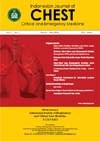 Pulmonologi Intervensi (1)
Vol 1 No 2 (2014)
Pulmonologi Intervensi (1)
Vol 1 No 2 (2014)Definisi
Flexible bronchoscopy merupakan suatu prosedur invasif untuk memvisualisasikan nasal, faring, laring, korda vokalis, dan percabangan trakea- bronkial untuk keperluan diagnosis serta pengobatan pada kelainan paru. Prosedur ini dapat dilakukan di ruang bronkoskopi, ruang endoskopi, kamar operasi, instalasi gawat darurat, ruang radiologi, dan di unit perawatan intensif
Peralatan
Peralatan yang diperlukan untuk melakukan prosedur adalah bronkoskop, lampu, sikat sitologi, forsep biopsi, needle aspiration catheter, suction, oksigen, fluoroskopi (C-arm), pulse oxymetry, sphygmomanometer dan peralatan resusitasi yang meliputi endotracheal tube serta monitor video. -
 Procedural Sedation and Analgesia (PSA) di bidang Pulmonologi Intervensi
Vol 1 No 2 (2014)
Procedural Sedation and Analgesia (PSA) di bidang Pulmonologi Intervensi
Vol 1 No 2 (2014)Tindakan prosedur di bidang pulmonologi intervensi seperti bronkoskopi fleksibel dan rigid serta pleuroskopi, menyebabkan nyeri dan ansietas. Pada pelaksanaan tindakan prosedur tersebut, klinisi umumnya dapat menggunakan anestesi lokal berupa infiltrasi lidocaine pada dinding thoraks dan pleura parietal (untuk pleuroskopi) serta inhalasi lidocaine dan lidocaine topikal (pada bronkoskopi). Selain itu, dapat digunakan sedasi dan analgesia prosedural (PSA), yang dapat mengurangi rasa tidak nyaman, ketakutan, dan timbulnya memori yang tidak menyenangkan akibat tindakan prosedur dan dapat memfasilitasi kelancaran tindakan prosedur tersebut
-
 Perbedaan Fungsi Paru pada Penderita Sindroma Metabolik dan Tanpa Sindroma Metabolik
Vol 1 No 2 (2014)
Perbedaan Fungsi Paru pada Penderita Sindroma Metabolik dan Tanpa Sindroma Metabolik
Vol 1 No 2 (2014)Background: Metabolic syndrome is a combination of central obesity, elevated blood pressure, impaired glucose metabolism, and dyslipidemia. Its prevalence is increasing worldwide. Several previous studies showed various differences of lung functions in patients with and without metabolic syndrome .
Objective: To determine whether patients with metabolic syndrome had lower FEV1 percent predicted and FVC percent predicted than normal population.
Methods: The study design was cross-sectional study. Patients were grouped into subjects with and without metabolic syndrome who met the inclusion and exclusion criteria.
Results: There were 96 subjects of the study with a mean age of 42.74 9.14. Metabolic syndrome group consisted of 48 subjects and there were 48 healthy subjects in control group. FVC percent predicted values in subjects with and without metabolic syndrome were 99.27 20.35 vs. 116.22 20.67 (p < 0.001), and FEV1 values were 116.05 23.77 vs 130.06 20.78 (p = 0.03). In patients with metabolic syndrome, 16.7% had FEV1 < 80% predicted that indicated decline in lung function (obstruction type), and 22.67% had FVC < 80 % predicted indicating a decline in lung function (restriction type).
Conclusion: Patient with metabolic syndrome had lower FEV1 and FVC values than normal population.
Keywords: Metabolic syndrome, pulmonary functions -
 Clinical Profile of Extrapulmonary Tuberculosis Among TB-HIV Patients in Cipto Mangunkusumo Hospital
Vol 1 No 2 (2014)
Clinical Profile of Extrapulmonary Tuberculosis Among TB-HIV Patients in Cipto Mangunkusumo Hospital
Vol 1 No 2 (2014)Pulmonary Tuberculosis (PTB) is a common manifestation in adults with TB-HIV co-infection. However, as the immunity gets worse, HIV-infected individuals more often develop extrapulmonary and disseminated TB. The Incidence of extrapulmonary TB (EPTB) has increased after the epidemic of HIV infection. It is responsible for 10-50% of all TB case among HIV negative individuals, while in HIV positive group, it occurs in 38-80%.1 Several studies found that up to 50% TB-HIV patients die during TB treatment.2,3 In Thailand, verbal autopsies, laboratorium data, and medical records of TB-HIV patients who die during TB treatment state that TB is the cause of death in 27% of those patients, whereas more than a half of them were disseminated and Multi Drug Resistant TB (Complicated EPTB).2
In many part of the world, many studies had mentioned susceptibility of HIV patients to develop extrapulmonary TB.4-6,8 Additionally, in the recent guideline to improve diagnosis and treatment of extrapulmonary TB, World Health Organization (WHO) states EPTB in HIV-infected person has become a new clinical problem especially in remote area where advance modality supporting diagnosis and treatment are unavalaible. Although pulmonary TB is the most common presentation of TB disease, it can involve any organ in the body. Extrapulmonary Tuberculosis is defined as the isolated occurrence of TB in any part of the body other than lungs such as lymph nodes, abdomen, genitourinary system, musculoskeletal and meninges. Mycobacteria may spread to any organ of the body through lymphatic or haematogenous dissemination and lie dormant for years at a particular site before causing disease. Manifestations may relate to the system involved, or simply as prolonged fever and non specific systemic symptoms. Tuberculosis is a worldwide disease and one of the major health problems of Indonesia. Extrapulmonary tuberculosis is increasing all over the world. However, only limited data is available about the situation of EPTB in developing countries including Indonesia, hence diagnosis may be elusive and is usually delayed.1,3 This study reviews the general spectrum of cases diagnosed with EPTB at a large HIV referral center (POKDISUS) and presents their key demographics, dominant infection sites and the laboratory findings.Key words: Extrapulmonary Tuberculosis, HIV
-
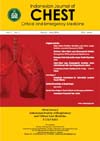 Penyakit Paru Obstruktif Kronik
Vol 1 No 2 (2014)
Penyakit Paru Obstruktif Kronik
Vol 1 No 2 (2014)Penyakit Paru Obstruktif Kronis (PPOK) merupakan salah satu penyakit yang memilki beban kesehatan tertinggi.World Health Organization (WHO) dalam Global Status of Non-communicable Diseases tahun 2010 mengkategorikan PPOK ke dalam empat besar penyakit tidak menular yang memiliki angka kematian yang tinggi setelah penyakit kardiovaskular, keganasan dan diabetes. GOLD Report 2014 menjelaskan bahwa biaya untuk kesehatan yang diakibatkan PPOK adalah 56% dari total biaya yang harus dibayar untuk penyakit respirasi. Biaya yang paling tinggi adalah diakibatkan kejadian eksaserbasi dari penyakit ini.1 Kematian menjadi beban sosial yang paling buruk yang diakibatkan oleh PPOK, namun diperlukan parameter yang bersifat konsisten untuk mengukur beban sosial. Parameter yang dapat digunakan adalah Disability-Adjusted Life Year (DALY), yaitu hasil dari penjumlahan antara Years of Life Lost (YLL) dan Years Lived with Disability (YLD). Berdasarkan hasil perhitungan tersebut, diperkirakan pada tahun 2030, PPOK akan menempati peringkat ketujuh, dimana sebelumnya pada tahun 1990 penyakit ini menempati urutan keduabelas
-
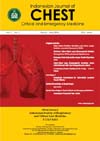 Hubungan antara Jarak Waktu Trakeostomi dengan Mortalitas Pasien Kritis Terventilasi Mekanik di Unit Perawatan Intensif
Vol 1 No 2 (2014)
Hubungan antara Jarak Waktu Trakeostomi dengan Mortalitas Pasien Kritis Terventilasi Mekanik di Unit Perawatan Intensif
Vol 1 No 2 (2014)Latar belakang: Prosedur trakeostomi dapat menurunkan hambatan udara (apabila dibandingkan dengan selang endotrakea), memiliki potensi untuk menurunkan penggunaan obat sedasi dan analgesia sehingga dapat memfasilitasi proses penyapihan dan menghindari pneumonia terkait ventilator. Batasan waktu atau saat yang optimal untuk melakukan trakeostomi pada pasien tersebut hingga kini masih dalam perdebatan. Berbagai penelitian terdahulu menunjukkan hasil keluaran yang berbeda-beda terutama terhadap insiden mortalitas dan morbiditas. Tujuan: Mengetahui insiden mortalitas pada pasien dengan trakeostomi dini dan trakeostomi lanjut di unit perawatan intensif dan hubungan antara jarak waktu trakeostomi dengan mortalitas perawatan unit intensif. Metode: Penelitian dengan desain kohort retrospektif, dilakukan terhadap 162 pasien kritis dengan ventilasi mekanik yang menerima tindakan trakeostomi selama perawatan intensif di RSUPN Dr. Cipto Mangunkusumo pada kurun waktu Januari 2008-Desember 2012. Data saat untuk melakukan trakeostomi, klinis, laboratorium,
dan radiologis dikumpulkan. Pasien diamati untuk melihat kejadian mortalitas selama perawatan intensif. Analisis hubungan antara saat trakeostomi dengan mortalitas perawatan intensif menggunakan tes X2. Analisis multivariat dengan regresi logistik digunakan untuk menghitung adjusted odds ratio (dan interval kepercayaan 95%) antara kelompok trakeostomi dini dan lanjut untuk terjadinya mortalitas perawatan intensif dengan memasukkan variabel-variabel perancu sebagai kovariat.
Hasil: Terdapat hubungan yang tidak bermakna antara trakeostomi dini dan lanjut dengan mortalitas unit perawatan intensif pada uji X2 (p=0,07) dengan RR 0,67 (IK95% 0,51-1,05). Insiden mortalitas pada trakeostomi dini dan lanjut sebesar 28,4% dan 42%.
Kesimpulan: Kelompok trakeostomi dini cenderung untuk memiliki insiden mortalitas yang lebih rendah dibandingkan dengan trakeostomi lanjut. Namun saat trakeostomi tidak berhubungan dengan mortalitas unit perawatan intensif secara statistik.
Kata kunci: Jarak waktu trakeostomi, unit perawatan intensive, mortalitas -
 LEUCOCYTE, NEUTROPHILS COUNTS AND PROCALCITONIN LEVELS IN SALMONELLA AND GRAM-NEGATIVE BACTEREMIAS
Vol 4 No 1 (2017)
LEUCOCYTE, NEUTROPHILS COUNTS AND PROCALCITONIN LEVELS IN SALMONELLA AND GRAM-NEGATIVE BACTEREMIAS
Vol 4 No 1 (2017)Procalcitonin (PCT) is a protein composed of 116 amino acid with a molecular mass of 13 kDa.1 The definite source of serum PCT is uncertain, but it has been speculated that PCT is produced by liver cells, monocytes
cells, and macrophage cells in response to infection.2 Serum PCT levels increase rapidly during various bacterial infection, especially Gram-negative bacterial infections.3 The outer membrane component of Gram-negative bacteria (i.e. endotoxin or lipopolysaccharides) has been shown to be a strong inducer of PCT
during bacterial infection. These bacteria cause the host to produce pro-inflammatory cytokines,
which leads to increased PCT production.3,4 Elevated cytokines levels also cause the host to
increase production of leucocyte and neutrophils cells. The lipopolysaccharides component plays
a large role in the severity of Gram-negative infections. In clinical settings, PCT together with
leucocyte and neutrophil counts are commonly used as markers of infection.5
Salmonella species, a cause of typhoid fever, are also Gram-negative bacteria that contain endotoxin on their cell surface. Binding of salmonella endotoxin to CD14/Toll-like receptor (TLR)4 on macrophage cells activates
nuclear factor kappa B (NF?B) to produce pro-inflammatory cytokine and increase inflammatory cytokines, resulting in elevated PCT levels.6,8 In clinical practice, leucocyte and neutrophil counts can be used as a marker of bacterial infection.9 In addition, several studies have reported that serum PCT levels are useful
in distinguishing Gram-negative bacteremia from Gram-positive bacteremia.3,10 However,
there have been no studies comparing laboratory markers of bacterial infection in Gram-negative
and Salmonella bacteremias. Therefore, we conduct this study to investigate the differences
in leucocyte and neutrophil cell counts and PCT levels among Salmonella and Gram-negative
bacteremias. -
 Acute Postpapartum Pulmonary Edema in a 34-year-old Preeclampsia Woman
Vol 4 No 1 (2017)
Acute Postpapartum Pulmonary Edema in a 34-year-old Preeclampsia Woman
Vol 4 No 1 (2017)Postpartum pulmonary edema is a rare clinical entity.1 Acute pulmonary edema, which signifies severe disease, is a leading cause of death in women with preeclampsia, and the fourth most common form of maternal morbidity. It is also frequently the reason for intensive care admission, and may occur during antenatal, intrapartum or postpartum periods.2 Pulmonary edema complicates around 0,05% of low-risk pregnancies but may develop in up to 2,9% of pregnancies complicated by preeclampsia3-4, with 70% of cases occurring after birth.2-3 A clinician needs to be aware of the physiologic changes in the maternal cardiovascular system that accompany pregnancy predispose to the development of pulmonary edema, such as increase in plasma blood volume, cardiac output, heart rate, and capillary permeability and a decrease in plasma colloid osmotic pressure. Resuscitation is the foremost priority, followed by formulation of a differential diagnosis to address the underlying condition.4 Here we report a postpartum patient who presented with acute pulmonary edema with severe respiratory compromise.
-
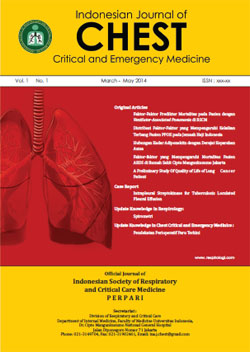 Efektivitas Kortikosteroid sebagai Terapi Adjuvan pada Pneumonia Komunitas Berat: Laporan Kasus Berbasis Bukti
Vol 4 No 1 (2017)
Efektivitas Kortikosteroid sebagai Terapi Adjuvan pada Pneumonia Komunitas Berat: Laporan Kasus Berbasis Bukti
Vol 4 No 1 (2017)Pneumonia komunitas (PK) adalah penyakit infeksi yang umum namun bersifat serius. Pneumonia komunitas termasuk dalam 10 penyebab kematian tertinggi di dunia.1 Terapi antimikrobial telah diketahui merupakan titik berat tata laksana PK dimana tingkat fatalitas sebelum era terapi antimikrobial adalah 80% dan setelahnya turun menjadi 20%.2 Namun demikian, sekarang ini terapi antimikrobial saja terkadang tidak cukup adekuat untuk menurunkan mortalitas pada pneumonia berat.2 Pada patogenesis PK, sitokin inflamasiseperti IL-6, IL-8, dan IL-10 berlaku sebagai protein fase akut dimana jumlah berlebih dari IL-6 dan IL-10 telah diasosiasikan dengan tingginya mortalitas pada PK.3 Kortikosteroid atau glukokortikoid adalah obat anti-inflamasi yang paling efektif dan paling banyak digunakan.1 Berbagai penelitian telah dilakukan untuk menginvestigasi manfaat penggunaan steroid sebagai terapi adjuvan pada pneumonia dengan hasil yang beragam. Sebagian studi menunjukkan bahwa pemberian kortikosteroid dosis sedang melalui intravena dapat menumpulkan respon sistemik sitokin pro-inflamatorik pada sepsis berat dan inflamasi paru pada pneumonia berat dan cidera paru akut.1 Namun demikian, studi lain mengatakan bahwa tidak ada data yang mendukung manfaat penggunaan steroid sistemik dalam perawatan rutin pneumonia.4 Ditambah lagi, meskipun penggunaan kortikosteroid tampak menguntungkan, perlu diingat bahwa penggunaan steroid diketahui memiliki berbagai efek samping.5Sampai saat ini, keuntungan penggunaan steroid untuk pengobatan pneumonia berat dianggap masih kontroversial, sehingga dibutuhkan kajian berbasis bukti untuk membahas hal tersebut lebih lanjut.
-
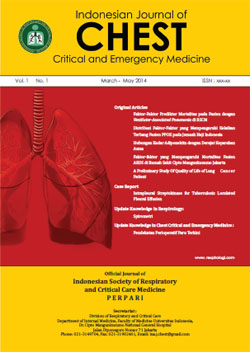 Epicardial Adipose Tissue Thickness as A Predictor Of Coronary Le sion Se verity In St able Coronary Arte ry Disease Patients
Vol 4 No 1 (2017)
Epicardial Adipose Tissue Thickness as A Predictor Of Coronary Le sion Se verity In St able Coronary Arte ry Disease Patients
Vol 4 No 1 (2017)Cardiovascular disease is the leading global cause of death, accounting for 17,3 million deaths per year, a number that is expected to grow to more than 23.6 million by 2030.1Of these deaths, an estimated 7,3 million were due to CAD.2Inflammation plays an integral role in the pathogenesis of atherosclerotic CAD.3-5 Therefore the interest in the EAT that is located between the myocardium and the pericardium surrounding both ventricles with variable extent and distribution patterns arouse.6-8 Because of its endocrine and paracrine activity, secreting pro-inflammatory and anti-inflammatory cytokines and chemokines, it has been suggested to influence coronary atherosclerosis development.9-13 TTE enables non-invasive assessment of EAT.14,15To date, the correlation of EAT with severity of CAD in Indonesia remains unknown. To address this issue, we examined the relationship between EAT thickness measured by TTE with coronary lesion severity in Indonesian patients with stable CAD. Methods Study Design The study was designed as an observational cross-sectional study. It was approved by Hasanuddin University ethic committee and written informed consent was obtained from all participants.
-
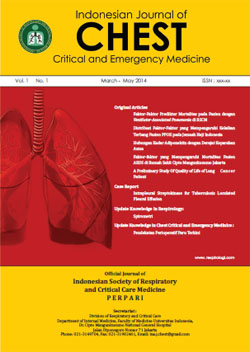 Pelacakan Pasien TB MDR Terkonfirmasi Yang Belum Memulai Pengobatan Di RSUP Dr. Hasan Sadikin Bandung Periode April 2012 � Februari 2015
Vol 4 No 1 (2017)
Pelacakan Pasien TB MDR Terkonfirmasi Yang Belum Memulai Pengobatan Di RSUP Dr. Hasan Sadikin Bandung Periode April 2012 � Februari 2015
Vol 4 No 1 (2017)Sampai saat ini TB masih merupakan salah satu penyakit menular yang mematikan di dunia. Pada tahun 2013 diperkirakan sekitar 9 juta orang terjangkit penyakit ini dengan kematian pada 1,5 juta penderitanya. Dari jumlah tersebut, 360 ribu diantaranya mengidap HIV positif. Tuberkulosis secara perlahan menurun kasusnya dan diperkirakan sekitar 37 juta nyawa telah berhasil diselamatkan antara tahun 2000 s.d tahun 2013 seiring bertambah efektifnya proses diagnosis dan pengobatan. Kendati demikian, angka kematian yang tinggi tersebut sebenarnya kurang bisa diterima karena sejatinya hal tersebut dapat dicegah. Dibutuhkan upaya yang lebih keras untuk bisa mencapai target global pada tahun 2015 seperti tertuang dalam Millenium Development Goals (MDGs). Selain itu, upaya pemberantasan penyakit tuberkulosis saat ini diperberat dengan meningkatnya kejadian infeksi HIV serta munculnya kasus-kasus MDR TB
Pada tahun 1995, program nasional pengendalian TB mulai menerapkan strategi DOTS dan dilaksanakan di Puskesmas secara bertahap. Sejak tahun 2000 strategi DOTS dilaksanakan secara Nasional di seluruh UPK terutama Puskesmas yang di integrasikan dalam pelayanan kesehatan dasar.2 Dalam perkembangan beberapa tahun terkahir, penanggulangan TB di Indonesia saat ini sudah lebih baik, hal ini terlihat dari peringkat negara Indonesia dengan kasus TB terbanyak yang menurun menjadi peringkat 5.3 Walaupun demikian, Indonesia adalah negara high burden dan sedang memperluas strategi DOTS dengan cepat. Jika tidak bekerja sama dengan Puskesmas, maka banyak pasien yang didiagnosis oleh rumah sakit memiliki risiko tinggi dalam kegagalan pengobatan dan mungkin menimbulkan kekebalan obat.4
Multidrugs Resistant Tuberculosis merupakan masalah terbesar terhadap pencegahan dan pemberantasan TB dunia.6 Pada tahun 2003 WHO menyatakan insidens MDR TB meningkat secara bertahap rerata 2%. Prevalensi TB Indonesia tahun 2006 adalah 253/100.000 penduduk dan angka kematian 38/100.000 penduduk. Pada tuberkulosis kasus baru didapatkan TB-MDR 2% dan pada TB kasus yang sudah diobati didapatkan MDR TB 19 %.5 Untuk Indonesia, TB MDR berada di urutan ke 8 dari 27 negara dengan kasus TB MDR terbanyak.3 Hasil penelitian Sri Melati Munir, Arifin Nawas dan Dianiati K Soetoyo dari Departemen Pulmonologi dan Ilmu Kedokteran Respirasi FKUI-RS Persahabatan Jakarta mendapatkan kesimpulan bahwa resisten Obat Anti Tuberkulosis (OAT) yang terbanyak adalah resisten sekunder 77,2% dan didominasi resisten terhadap rifampisin dan isoniazid 50,5% sedangkan resistensi primer sebesar 22,8%. Baik pada resistensi primer maupun sekunder didapatkan resisten terhadap rifampisin dan isoniazid 50,5 %, resisten terhadap rifampisin, isoniazid dan streptomisin 34,6%. Tulang punggung pengobatan TB adalah rifampisin dan isoniazid. Namun demikian, paling banyak terjadi resistensi.7



